Leading Change: Strategy, Operations, and Leadership in Subway/Greggs
VerifiedAdded on 2024/06/07
|26
|5695
|166
Report
AI Summary
This report compares and contrasts the change management strategies of Subway and Greggs, two prominent firms in the food industry. It examines the influence of both internal and external change drivers on team dynamics, leadership behavior, and individual performance within these organizations. The report evaluates measures to minimize the negative impacts of change and applies relevant theories and models to critically assess each firm's response. Furthermore, it identifies barriers to change and uses force field analysis to understand the driving and resisting forces affecting decision-making, particularly within Subway. Finally, the report explores various leadership approaches for effectively managing organizational change and concludes with an assessment of the extent to which these approaches contribute to successful implementation.
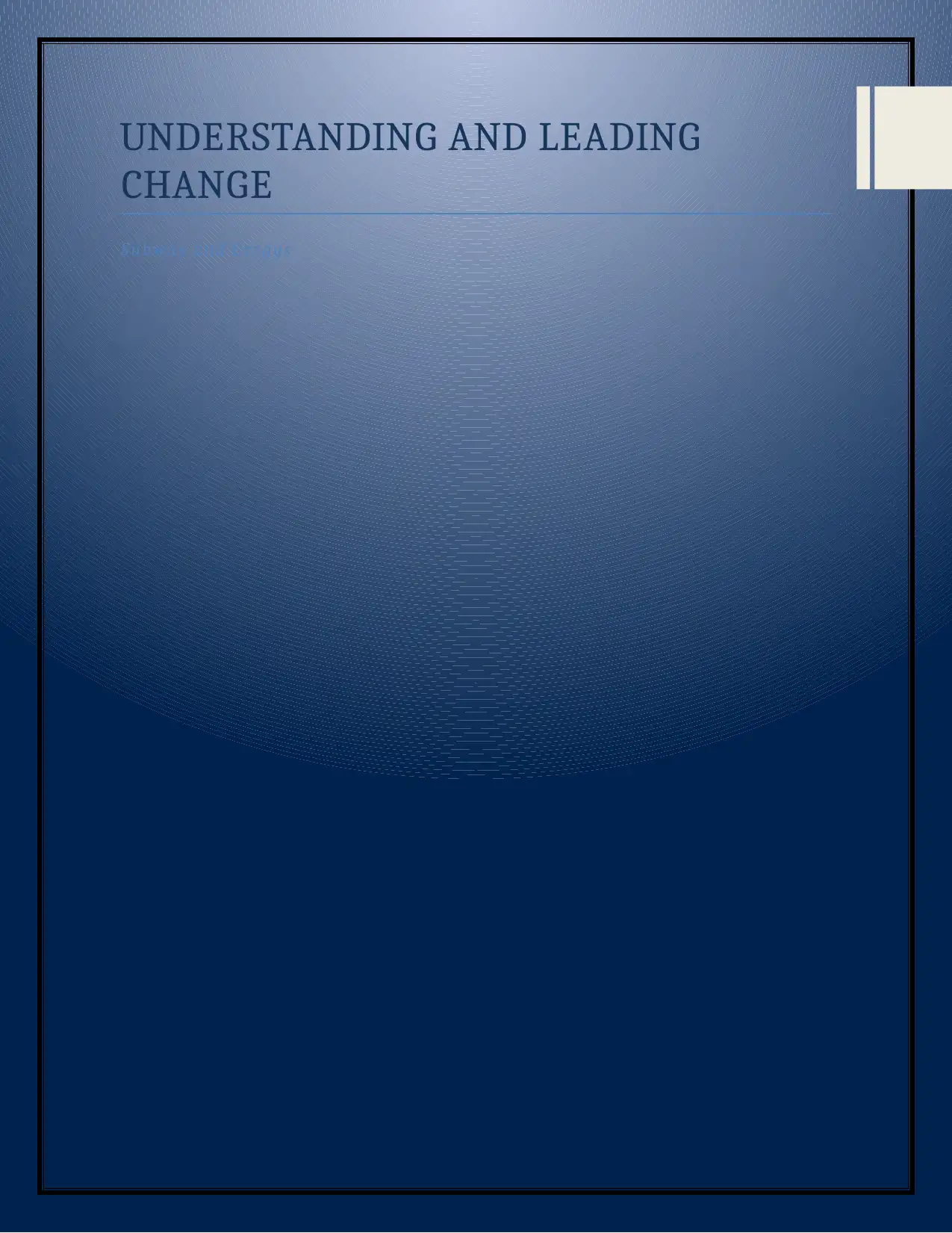
UNDERSTANDING AND LEADING
CHANGE
Subway and Greggs
CHANGE
Subway and Greggs
Paraphrase This Document
Need a fresh take? Get an instant paraphrase of this document with our AI Paraphraser
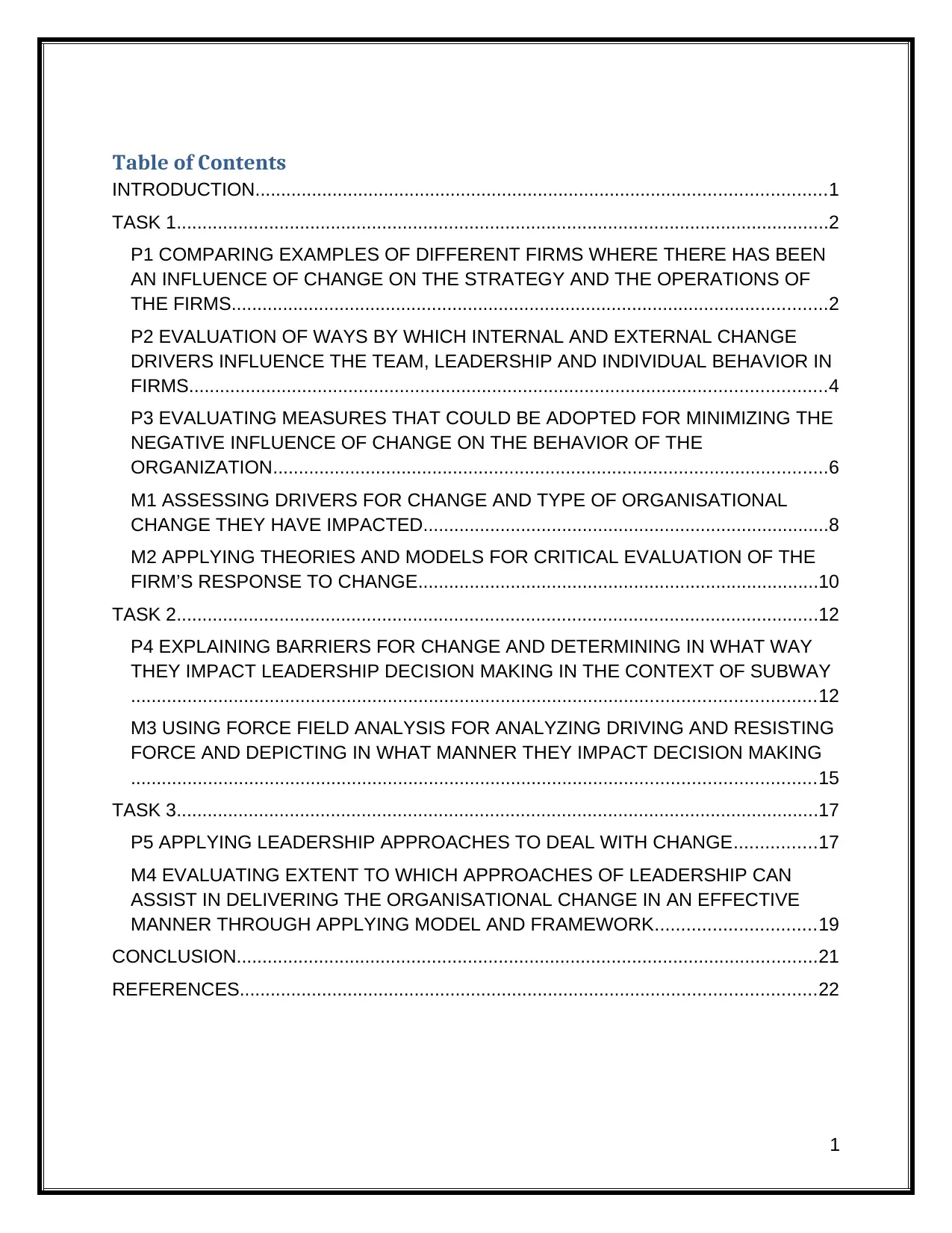
Table of Contents
INTRODUCTION...............................................................................................................1
TASK 1...............................................................................................................................2
P1 COMPARING EXAMPLES OF DIFFERENT FIRMS WHERE THERE HAS BEEN
AN INFLUENCE OF CHANGE ON THE STRATEGY AND THE OPERATIONS OF
THE FIRMS....................................................................................................................2
P2 EVALUATION OF WAYS BY WHICH INTERNAL AND EXTERNAL CHANGE
DRIVERS INFLUENCE THE TEAM, LEADERSHIP AND INDIVIDUAL BEHAVIOR IN
FIRMS............................................................................................................................4
P3 EVALUATING MEASURES THAT COULD BE ADOPTED FOR MINIMIZING THE
NEGATIVE INFLUENCE OF CHANGE ON THE BEHAVIOR OF THE
ORGANIZATION............................................................................................................6
M1 ASSESSING DRIVERS FOR CHANGE AND TYPE OF ORGANISATIONAL
CHANGE THEY HAVE IMPACTED...............................................................................8
M2 APPLYING THEORIES AND MODELS FOR CRITICAL EVALUATION OF THE
FIRM’S RESPONSE TO CHANGE..............................................................................10
TASK 2.............................................................................................................................12
P4 EXPLAINING BARRIERS FOR CHANGE AND DETERMINING IN WHAT WAY
THEY IMPACT LEADERSHIP DECISION MAKING IN THE CONTEXT OF SUBWAY
.....................................................................................................................................12
M3 USING FORCE FIELD ANALYSIS FOR ANALYZING DRIVING AND RESISTING
FORCE AND DEPICTING IN WHAT MANNER THEY IMPACT DECISION MAKING
.....................................................................................................................................15
TASK 3.............................................................................................................................17
P5 APPLYING LEADERSHIP APPROACHES TO DEAL WITH CHANGE................17
M4 EVALUATING EXTENT TO WHICH APPROACHES OF LEADERSHIP CAN
ASSIST IN DELIVERING THE ORGANISATIONAL CHANGE IN AN EFFECTIVE
MANNER THROUGH APPLYING MODEL AND FRAMEWORK...............................19
CONCLUSION.................................................................................................................21
REFERENCES................................................................................................................22
1
INTRODUCTION...............................................................................................................1
TASK 1...............................................................................................................................2
P1 COMPARING EXAMPLES OF DIFFERENT FIRMS WHERE THERE HAS BEEN
AN INFLUENCE OF CHANGE ON THE STRATEGY AND THE OPERATIONS OF
THE FIRMS....................................................................................................................2
P2 EVALUATION OF WAYS BY WHICH INTERNAL AND EXTERNAL CHANGE
DRIVERS INFLUENCE THE TEAM, LEADERSHIP AND INDIVIDUAL BEHAVIOR IN
FIRMS............................................................................................................................4
P3 EVALUATING MEASURES THAT COULD BE ADOPTED FOR MINIMIZING THE
NEGATIVE INFLUENCE OF CHANGE ON THE BEHAVIOR OF THE
ORGANIZATION............................................................................................................6
M1 ASSESSING DRIVERS FOR CHANGE AND TYPE OF ORGANISATIONAL
CHANGE THEY HAVE IMPACTED...............................................................................8
M2 APPLYING THEORIES AND MODELS FOR CRITICAL EVALUATION OF THE
FIRM’S RESPONSE TO CHANGE..............................................................................10
TASK 2.............................................................................................................................12
P4 EXPLAINING BARRIERS FOR CHANGE AND DETERMINING IN WHAT WAY
THEY IMPACT LEADERSHIP DECISION MAKING IN THE CONTEXT OF SUBWAY
.....................................................................................................................................12
M3 USING FORCE FIELD ANALYSIS FOR ANALYZING DRIVING AND RESISTING
FORCE AND DEPICTING IN WHAT MANNER THEY IMPACT DECISION MAKING
.....................................................................................................................................15
TASK 3.............................................................................................................................17
P5 APPLYING LEADERSHIP APPROACHES TO DEAL WITH CHANGE................17
M4 EVALUATING EXTENT TO WHICH APPROACHES OF LEADERSHIP CAN
ASSIST IN DELIVERING THE ORGANISATIONAL CHANGE IN AN EFFECTIVE
MANNER THROUGH APPLYING MODEL AND FRAMEWORK...............................19
CONCLUSION.................................................................................................................21
REFERENCES................................................................................................................22
1
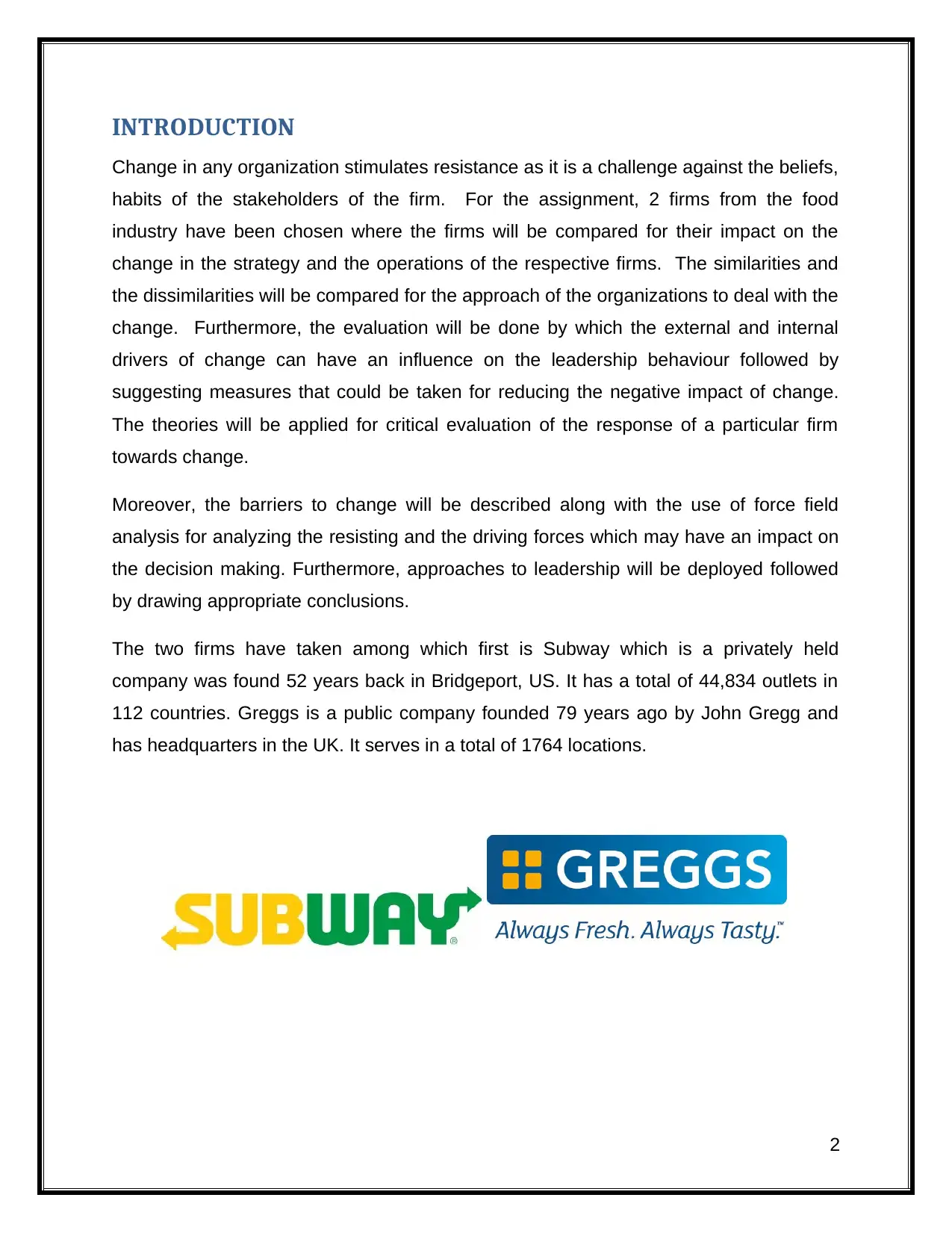
INTRODUCTION
Change in any organization stimulates resistance as it is a challenge against the beliefs,
habits of the stakeholders of the firm. For the assignment, 2 firms from the food
industry have been chosen where the firms will be compared for their impact on the
change in the strategy and the operations of the respective firms. The similarities and
the dissimilarities will be compared for the approach of the organizations to deal with the
change. Furthermore, the evaluation will be done by which the external and internal
drivers of change can have an influence on the leadership behaviour followed by
suggesting measures that could be taken for reducing the negative impact of change.
The theories will be applied for critical evaluation of the response of a particular firm
towards change.
Moreover, the barriers to change will be described along with the use of force field
analysis for analyzing the resisting and the driving forces which may have an impact on
the decision making. Furthermore, approaches to leadership will be deployed followed
by drawing appropriate conclusions.
The two firms have taken among which first is Subway which is a privately held
company was found 52 years back in Bridgeport, US. It has a total of 44,834 outlets in
112 countries. Greggs is a public company founded 79 years ago by John Gregg and
has headquarters in the UK. It serves in a total of 1764 locations.
2
Change in any organization stimulates resistance as it is a challenge against the beliefs,
habits of the stakeholders of the firm. For the assignment, 2 firms from the food
industry have been chosen where the firms will be compared for their impact on the
change in the strategy and the operations of the respective firms. The similarities and
the dissimilarities will be compared for the approach of the organizations to deal with the
change. Furthermore, the evaluation will be done by which the external and internal
drivers of change can have an influence on the leadership behaviour followed by
suggesting measures that could be taken for reducing the negative impact of change.
The theories will be applied for critical evaluation of the response of a particular firm
towards change.
Moreover, the barriers to change will be described along with the use of force field
analysis for analyzing the resisting and the driving forces which may have an impact on
the decision making. Furthermore, approaches to leadership will be deployed followed
by drawing appropriate conclusions.
The two firms have taken among which first is Subway which is a privately held
company was found 52 years back in Bridgeport, US. It has a total of 44,834 outlets in
112 countries. Greggs is a public company founded 79 years ago by John Gregg and
has headquarters in the UK. It serves in a total of 1764 locations.
2
⊘ This is a preview!⊘
Do you want full access?
Subscribe today to unlock all pages.

Trusted by 1+ million students worldwide
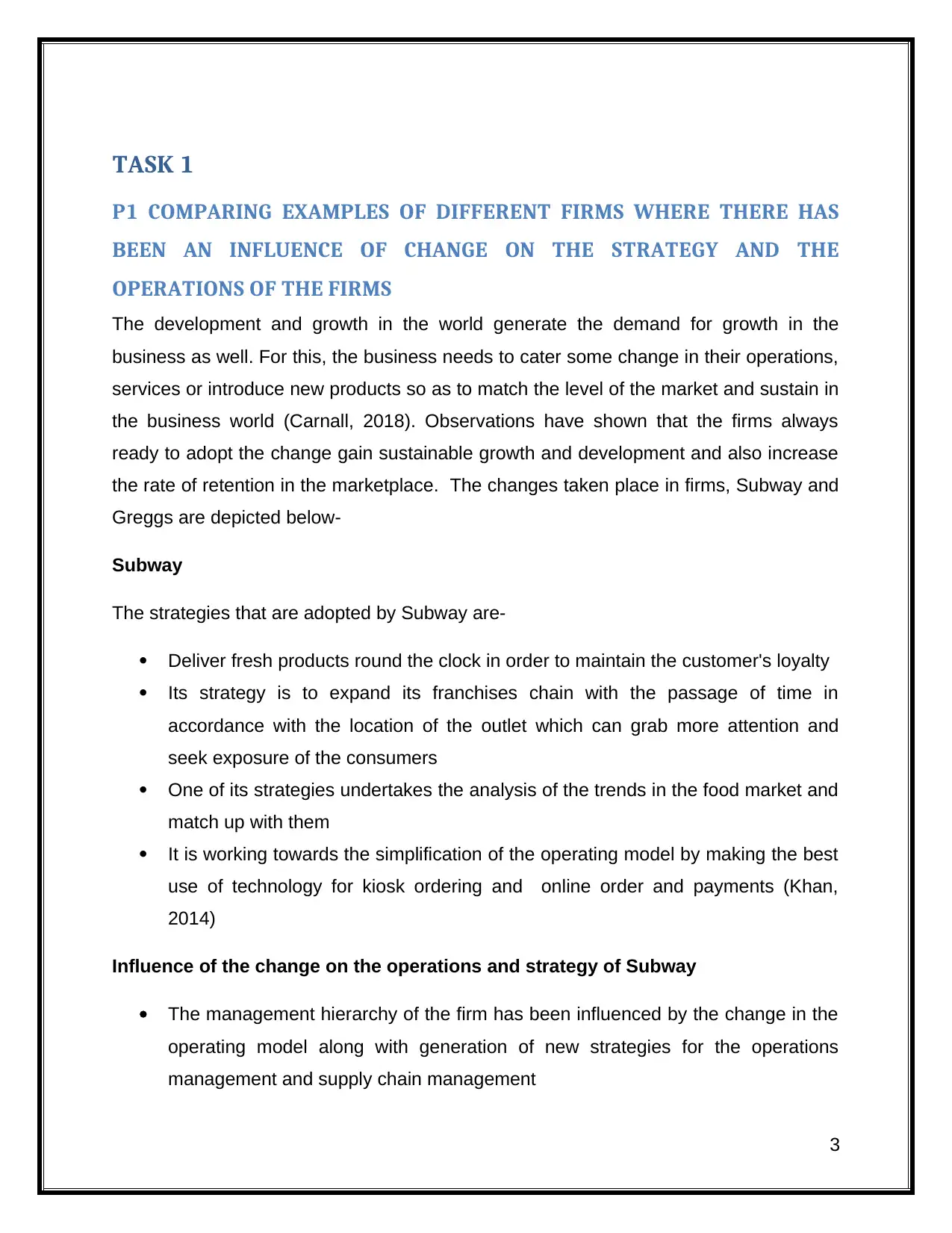
TASK 1
P1 COMPARING EXAMPLES OF DIFFERENT FIRMS WHERE THERE HAS
BEEN AN INFLUENCE OF CHANGE ON THE STRATEGY AND THE
OPERATIONS OF THE FIRMS
The development and growth in the world generate the demand for growth in the
business as well. For this, the business needs to cater some change in their operations,
services or introduce new products so as to match the level of the market and sustain in
the business world (Carnall, 2018). Observations have shown that the firms always
ready to adopt the change gain sustainable growth and development and also increase
the rate of retention in the marketplace. The changes taken place in firms, Subway and
Greggs are depicted below-
Subway
The strategies that are adopted by Subway are-
Deliver fresh products round the clock in order to maintain the customer's loyalty
Its strategy is to expand its franchises chain with the passage of time in
accordance with the location of the outlet which can grab more attention and
seek exposure of the consumers
One of its strategies undertakes the analysis of the trends in the food market and
match up with them
It is working towards the simplification of the operating model by making the best
use of technology for kiosk ordering and online order and payments (Khan,
2014)
Influence of the change on the operations and strategy of Subway
The management hierarchy of the firm has been influenced by the change in the
operating model along with generation of new strategies for the operations
management and supply chain management
3
P1 COMPARING EXAMPLES OF DIFFERENT FIRMS WHERE THERE HAS
BEEN AN INFLUENCE OF CHANGE ON THE STRATEGY AND THE
OPERATIONS OF THE FIRMS
The development and growth in the world generate the demand for growth in the
business as well. For this, the business needs to cater some change in their operations,
services or introduce new products so as to match the level of the market and sustain in
the business world (Carnall, 2018). Observations have shown that the firms always
ready to adopt the change gain sustainable growth and development and also increase
the rate of retention in the marketplace. The changes taken place in firms, Subway and
Greggs are depicted below-
Subway
The strategies that are adopted by Subway are-
Deliver fresh products round the clock in order to maintain the customer's loyalty
Its strategy is to expand its franchises chain with the passage of time in
accordance with the location of the outlet which can grab more attention and
seek exposure of the consumers
One of its strategies undertakes the analysis of the trends in the food market and
match up with them
It is working towards the simplification of the operating model by making the best
use of technology for kiosk ordering and online order and payments (Khan,
2014)
Influence of the change on the operations and strategy of Subway
The management hierarchy of the firm has been influenced by the change in the
operating model along with generation of new strategies for the operations
management and supply chain management
3
Paraphrase This Document
Need a fresh take? Get an instant paraphrase of this document with our AI Paraphraser
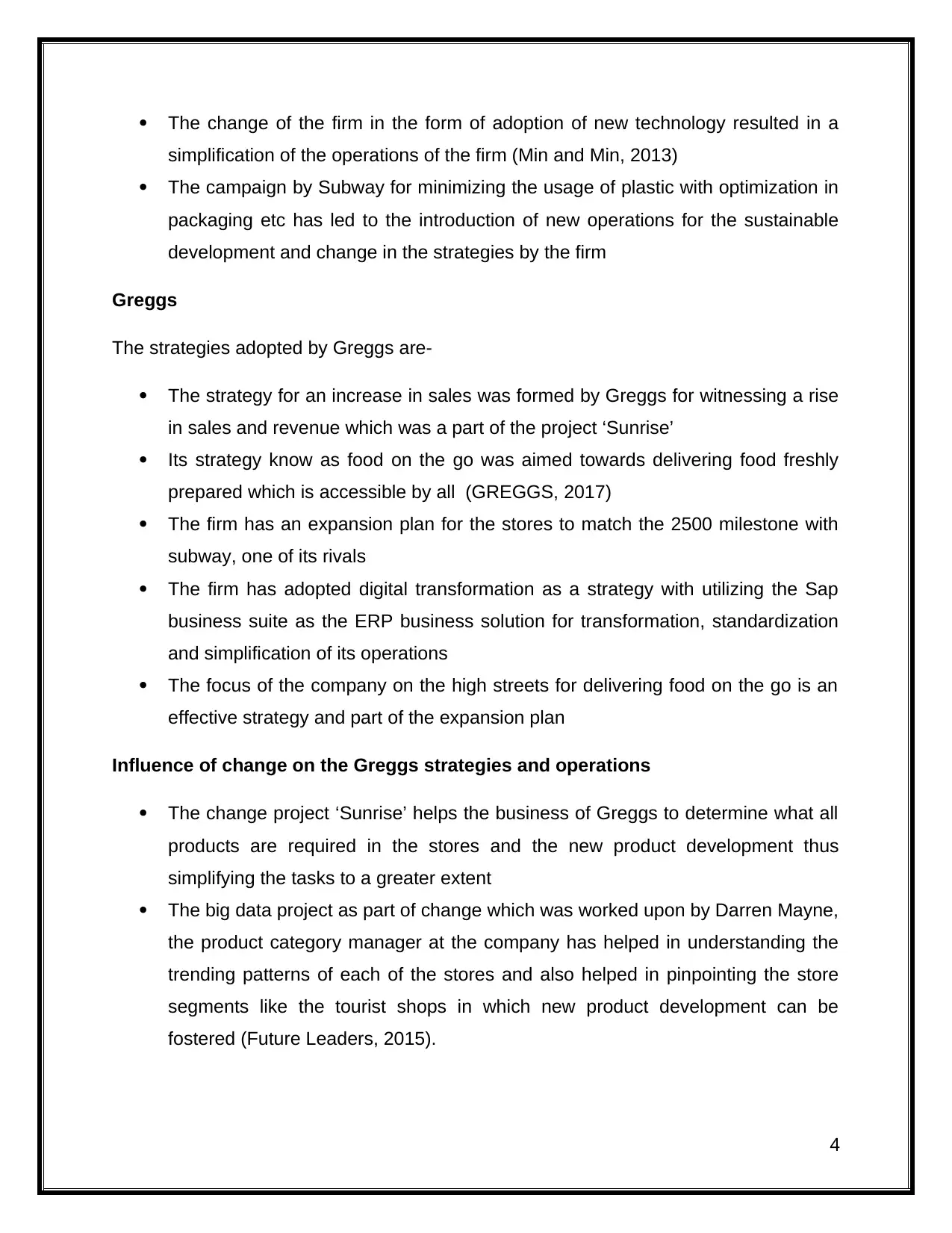
The change of the firm in the form of adoption of new technology resulted in a
simplification of the operations of the firm (Min and Min, 2013)
The campaign by Subway for minimizing the usage of plastic with optimization in
packaging etc has led to the introduction of new operations for the sustainable
development and change in the strategies by the firm
Greggs
The strategies adopted by Greggs are-
The strategy for an increase in sales was formed by Greggs for witnessing a rise
in sales and revenue which was a part of the project ‘Sunrise’
Its strategy know as food on the go was aimed towards delivering food freshly
prepared which is accessible by all (GREGGS, 2017)
The firm has an expansion plan for the stores to match the 2500 milestone with
subway, one of its rivals
The firm has adopted digital transformation as a strategy with utilizing the Sap
business suite as the ERP business solution for transformation, standardization
and simplification of its operations
The focus of the company on the high streets for delivering food on the go is an
effective strategy and part of the expansion plan
Influence of change on the Greggs strategies and operations
The change project ‘Sunrise’ helps the business of Greggs to determine what all
products are required in the stores and the new product development thus
simplifying the tasks to a greater extent
The big data project as part of change which was worked upon by Darren Mayne,
the product category manager at the company has helped in understanding the
trending patterns of each of the stores and also helped in pinpointing the store
segments like the tourist shops in which new product development can be
fostered (Future Leaders, 2015).
4
simplification of the operations of the firm (Min and Min, 2013)
The campaign by Subway for minimizing the usage of plastic with optimization in
packaging etc has led to the introduction of new operations for the sustainable
development and change in the strategies by the firm
Greggs
The strategies adopted by Greggs are-
The strategy for an increase in sales was formed by Greggs for witnessing a rise
in sales and revenue which was a part of the project ‘Sunrise’
Its strategy know as food on the go was aimed towards delivering food freshly
prepared which is accessible by all (GREGGS, 2017)
The firm has an expansion plan for the stores to match the 2500 milestone with
subway, one of its rivals
The firm has adopted digital transformation as a strategy with utilizing the Sap
business suite as the ERP business solution for transformation, standardization
and simplification of its operations
The focus of the company on the high streets for delivering food on the go is an
effective strategy and part of the expansion plan
Influence of change on the Greggs strategies and operations
The change project ‘Sunrise’ helps the business of Greggs to determine what all
products are required in the stores and the new product development thus
simplifying the tasks to a greater extent
The big data project as part of change which was worked upon by Darren Mayne,
the product category manager at the company has helped in understanding the
trending patterns of each of the stores and also helped in pinpointing the store
segments like the tourist shops in which new product development can be
fostered (Future Leaders, 2015).
4
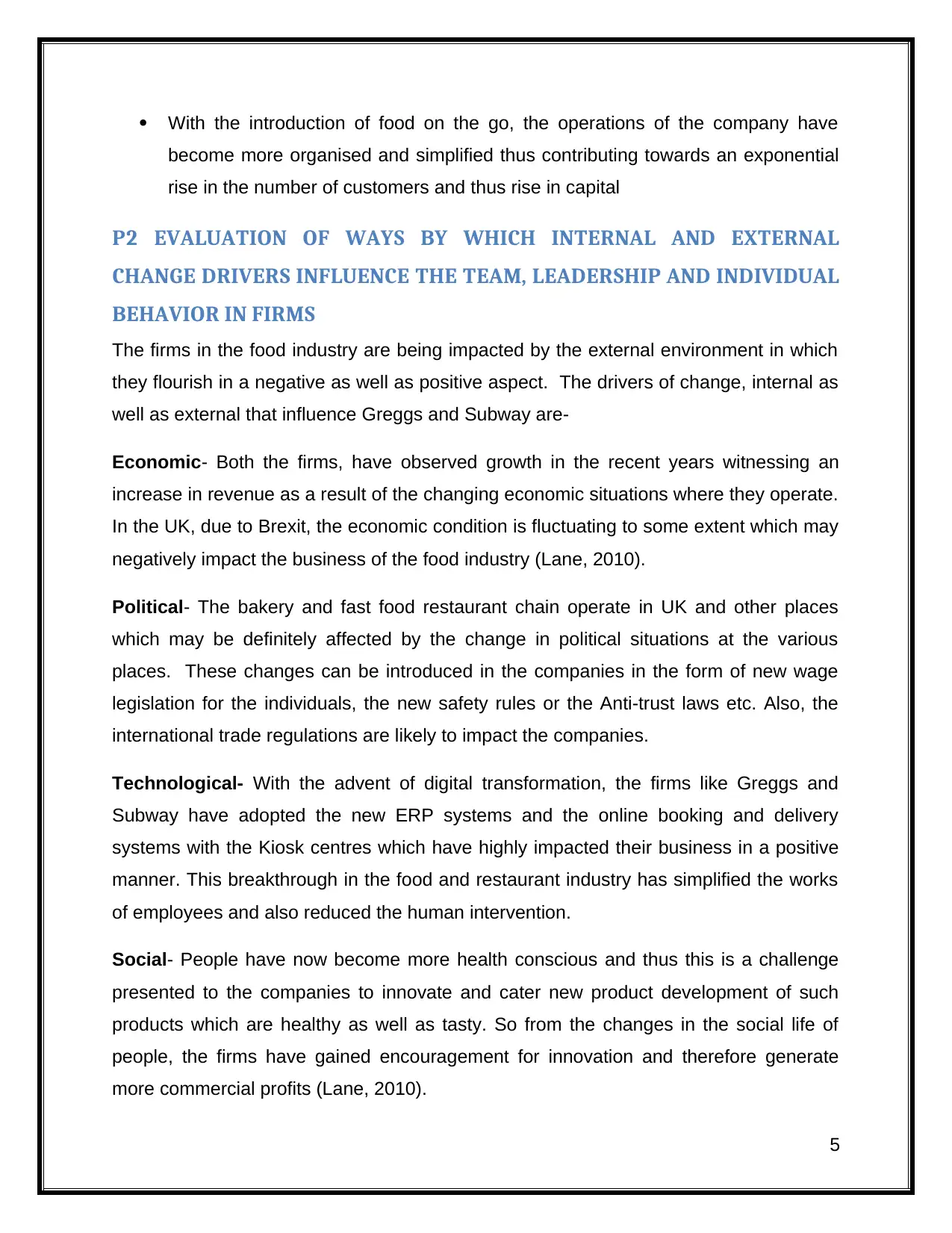
With the introduction of food on the go, the operations of the company have
become more organised and simplified thus contributing towards an exponential
rise in the number of customers and thus rise in capital
P2 EVALUATION OF WAYS BY WHICH INTERNAL AND EXTERNAL
CHANGE DRIVERS INFLUENCE THE TEAM, LEADERSHIP AND INDIVIDUAL
BEHAVIOR IN FIRMS
The firms in the food industry are being impacted by the external environment in which
they flourish in a negative as well as positive aspect. The drivers of change, internal as
well as external that influence Greggs and Subway are-
Economic- Both the firms, have observed growth in the recent years witnessing an
increase in revenue as a result of the changing economic situations where they operate.
In the UK, due to Brexit, the economic condition is fluctuating to some extent which may
negatively impact the business of the food industry (Lane, 2010).
Political- The bakery and fast food restaurant chain operate in UK and other places
which may be definitely affected by the change in political situations at the various
places. These changes can be introduced in the companies in the form of new wage
legislation for the individuals, the new safety rules or the Anti-trust laws etc. Also, the
international trade regulations are likely to impact the companies.
Technological- With the advent of digital transformation, the firms like Greggs and
Subway have adopted the new ERP systems and the online booking and delivery
systems with the Kiosk centres which have highly impacted their business in a positive
manner. This breakthrough in the food and restaurant industry has simplified the works
of employees and also reduced the human intervention.
Social- People have now become more health conscious and thus this is a challenge
presented to the companies to innovate and cater new product development of such
products which are healthy as well as tasty. So from the changes in the social life of
people, the firms have gained encouragement for innovation and therefore generate
more commercial profits (Lane, 2010).
5
become more organised and simplified thus contributing towards an exponential
rise in the number of customers and thus rise in capital
P2 EVALUATION OF WAYS BY WHICH INTERNAL AND EXTERNAL
CHANGE DRIVERS INFLUENCE THE TEAM, LEADERSHIP AND INDIVIDUAL
BEHAVIOR IN FIRMS
The firms in the food industry are being impacted by the external environment in which
they flourish in a negative as well as positive aspect. The drivers of change, internal as
well as external that influence Greggs and Subway are-
Economic- Both the firms, have observed growth in the recent years witnessing an
increase in revenue as a result of the changing economic situations where they operate.
In the UK, due to Brexit, the economic condition is fluctuating to some extent which may
negatively impact the business of the food industry (Lane, 2010).
Political- The bakery and fast food restaurant chain operate in UK and other places
which may be definitely affected by the change in political situations at the various
places. These changes can be introduced in the companies in the form of new wage
legislation for the individuals, the new safety rules or the Anti-trust laws etc. Also, the
international trade regulations are likely to impact the companies.
Technological- With the advent of digital transformation, the firms like Greggs and
Subway have adopted the new ERP systems and the online booking and delivery
systems with the Kiosk centres which have highly impacted their business in a positive
manner. This breakthrough in the food and restaurant industry has simplified the works
of employees and also reduced the human intervention.
Social- People have now become more health conscious and thus this is a challenge
presented to the companies to innovate and cater new product development of such
products which are healthy as well as tasty. So from the changes in the social life of
people, the firms have gained encouragement for innovation and therefore generate
more commercial profits (Lane, 2010).
5
⊘ This is a preview!⊘
Do you want full access?
Subscribe today to unlock all pages.

Trusted by 1+ million students worldwide
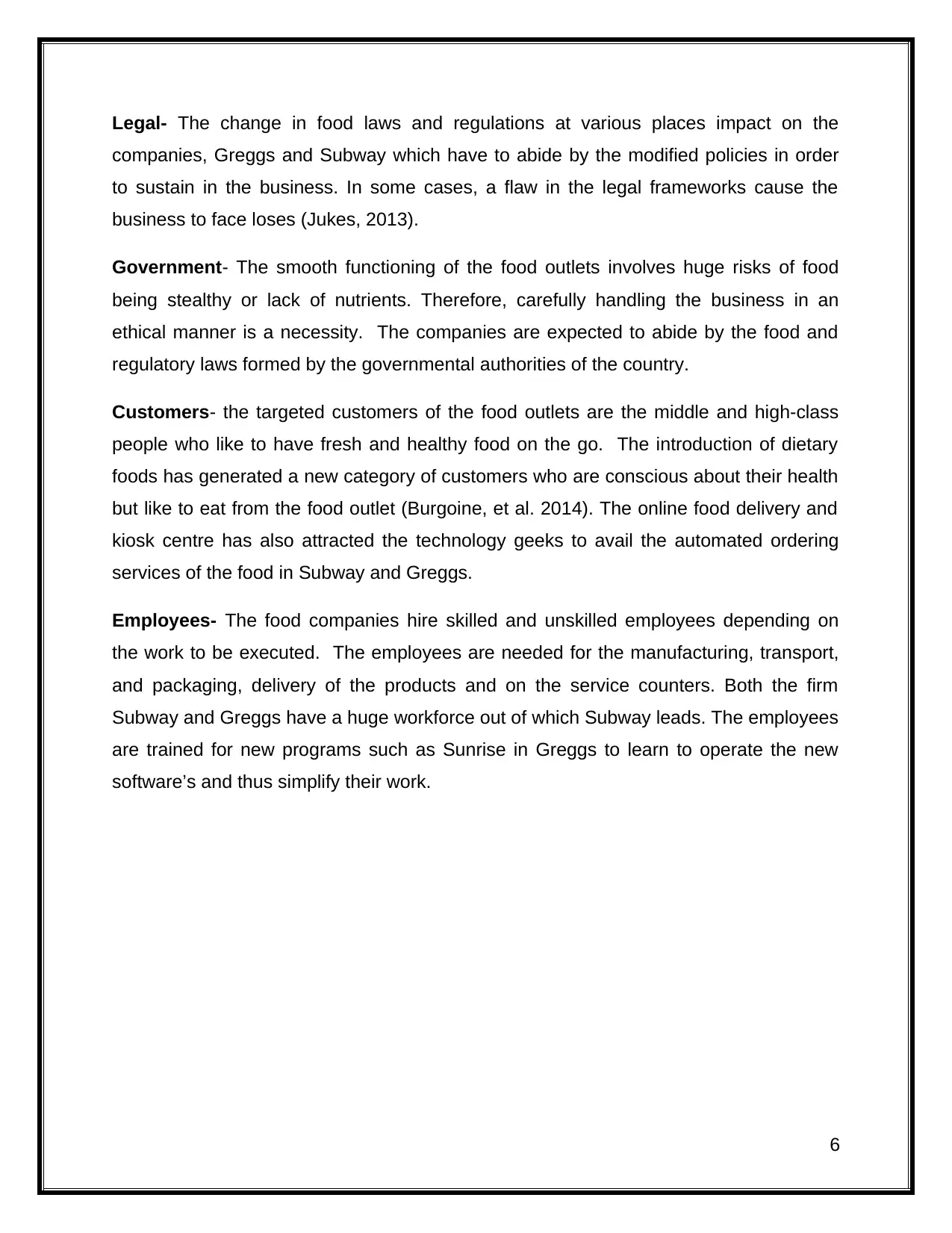
Legal- The change in food laws and regulations at various places impact on the
companies, Greggs and Subway which have to abide by the modified policies in order
to sustain in the business. In some cases, a flaw in the legal frameworks cause the
business to face loses (Jukes, 2013).
Government- The smooth functioning of the food outlets involves huge risks of food
being stealthy or lack of nutrients. Therefore, carefully handling the business in an
ethical manner is a necessity. The companies are expected to abide by the food and
regulatory laws formed by the governmental authorities of the country.
Customers- the targeted customers of the food outlets are the middle and high-class
people who like to have fresh and healthy food on the go. The introduction of dietary
foods has generated a new category of customers who are conscious about their health
but like to eat from the food outlet (Burgoine, et al. 2014). The online food delivery and
kiosk centre has also attracted the technology geeks to avail the automated ordering
services of the food in Subway and Greggs.
Employees- The food companies hire skilled and unskilled employees depending on
the work to be executed. The employees are needed for the manufacturing, transport,
and packaging, delivery of the products and on the service counters. Both the firm
Subway and Greggs have a huge workforce out of which Subway leads. The employees
are trained for new programs such as Sunrise in Greggs to learn to operate the new
software’s and thus simplify their work.
6
companies, Greggs and Subway which have to abide by the modified policies in order
to sustain in the business. In some cases, a flaw in the legal frameworks cause the
business to face loses (Jukes, 2013).
Government- The smooth functioning of the food outlets involves huge risks of food
being stealthy or lack of nutrients. Therefore, carefully handling the business in an
ethical manner is a necessity. The companies are expected to abide by the food and
regulatory laws formed by the governmental authorities of the country.
Customers- the targeted customers of the food outlets are the middle and high-class
people who like to have fresh and healthy food on the go. The introduction of dietary
foods has generated a new category of customers who are conscious about their health
but like to eat from the food outlet (Burgoine, et al. 2014). The online food delivery and
kiosk centre has also attracted the technology geeks to avail the automated ordering
services of the food in Subway and Greggs.
Employees- The food companies hire skilled and unskilled employees depending on
the work to be executed. The employees are needed for the manufacturing, transport,
and packaging, delivery of the products and on the service counters. Both the firm
Subway and Greggs have a huge workforce out of which Subway leads. The employees
are trained for new programs such as Sunrise in Greggs to learn to operate the new
software’s and thus simplify their work.
6
Paraphrase This Document
Need a fresh take? Get an instant paraphrase of this document with our AI Paraphraser
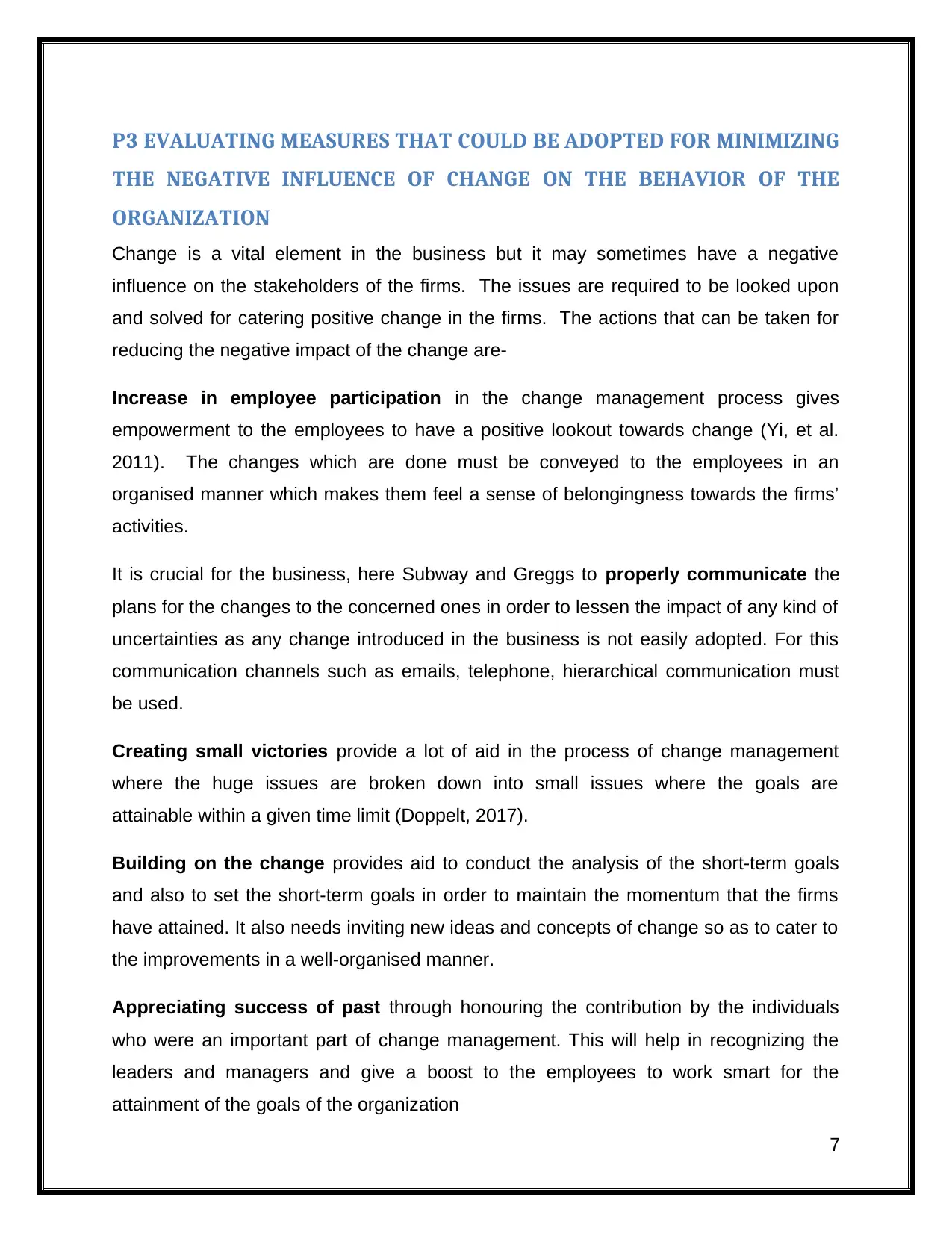
P3 EVALUATING MEASURES THAT COULD BE ADOPTED FOR MINIMIZING
THE NEGATIVE INFLUENCE OF CHANGE ON THE BEHAVIOR OF THE
ORGANIZATION
Change is a vital element in the business but it may sometimes have a negative
influence on the stakeholders of the firms. The issues are required to be looked upon
and solved for catering positive change in the firms. The actions that can be taken for
reducing the negative impact of the change are-
Increase in employee participation in the change management process gives
empowerment to the employees to have a positive lookout towards change (Yi, et al.
2011). The changes which are done must be conveyed to the employees in an
organised manner which makes them feel a sense of belongingness towards the firms’
activities.
It is crucial for the business, here Subway and Greggs to properly communicate the
plans for the changes to the concerned ones in order to lessen the impact of any kind of
uncertainties as any change introduced in the business is not easily adopted. For this
communication channels such as emails, telephone, hierarchical communication must
be used.
Creating small victories provide a lot of aid in the process of change management
where the huge issues are broken down into small issues where the goals are
attainable within a given time limit (Doppelt, 2017).
Building on the change provides aid to conduct the analysis of the short-term goals
and also to set the short-term goals in order to maintain the momentum that the firms
have attained. It also needs inviting new ideas and concepts of change so as to cater to
the improvements in a well-organised manner.
Appreciating success of past through honouring the contribution by the individuals
who were an important part of change management. This will help in recognizing the
leaders and managers and give a boost to the employees to work smart for the
attainment of the goals of the organization
7
THE NEGATIVE INFLUENCE OF CHANGE ON THE BEHAVIOR OF THE
ORGANIZATION
Change is a vital element in the business but it may sometimes have a negative
influence on the stakeholders of the firms. The issues are required to be looked upon
and solved for catering positive change in the firms. The actions that can be taken for
reducing the negative impact of the change are-
Increase in employee participation in the change management process gives
empowerment to the employees to have a positive lookout towards change (Yi, et al.
2011). The changes which are done must be conveyed to the employees in an
organised manner which makes them feel a sense of belongingness towards the firms’
activities.
It is crucial for the business, here Subway and Greggs to properly communicate the
plans for the changes to the concerned ones in order to lessen the impact of any kind of
uncertainties as any change introduced in the business is not easily adopted. For this
communication channels such as emails, telephone, hierarchical communication must
be used.
Creating small victories provide a lot of aid in the process of change management
where the huge issues are broken down into small issues where the goals are
attainable within a given time limit (Doppelt, 2017).
Building on the change provides aid to conduct the analysis of the short-term goals
and also to set the short-term goals in order to maintain the momentum that the firms
have attained. It also needs inviting new ideas and concepts of change so as to cater to
the improvements in a well-organised manner.
Appreciating success of past through honouring the contribution by the individuals
who were an important part of change management. This will help in recognizing the
leaders and managers and give a boost to the employees to work smart for the
attainment of the goals of the organization
7
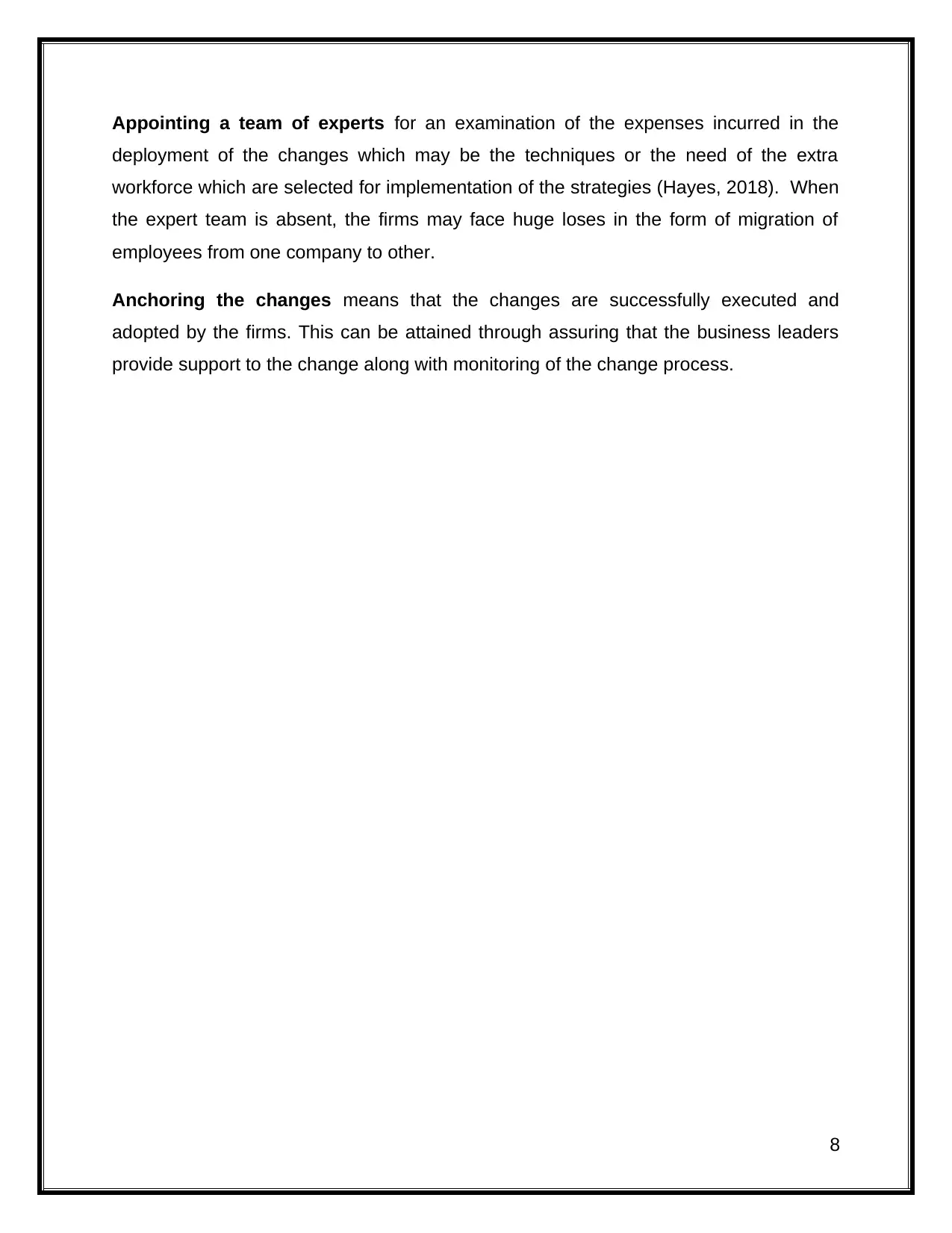
Appointing a team of experts for an examination of the expenses incurred in the
deployment of the changes which may be the techniques or the need of the extra
workforce which are selected for implementation of the strategies (Hayes, 2018). When
the expert team is absent, the firms may face huge loses in the form of migration of
employees from one company to other.
Anchoring the changes means that the changes are successfully executed and
adopted by the firms. This can be attained through assuring that the business leaders
provide support to the change along with monitoring of the change process.
8
deployment of the changes which may be the techniques or the need of the extra
workforce which are selected for implementation of the strategies (Hayes, 2018). When
the expert team is absent, the firms may face huge loses in the form of migration of
employees from one company to other.
Anchoring the changes means that the changes are successfully executed and
adopted by the firms. This can be attained through assuring that the business leaders
provide support to the change along with monitoring of the change process.
8
⊘ This is a preview!⊘
Do you want full access?
Subscribe today to unlock all pages.

Trusted by 1+ million students worldwide
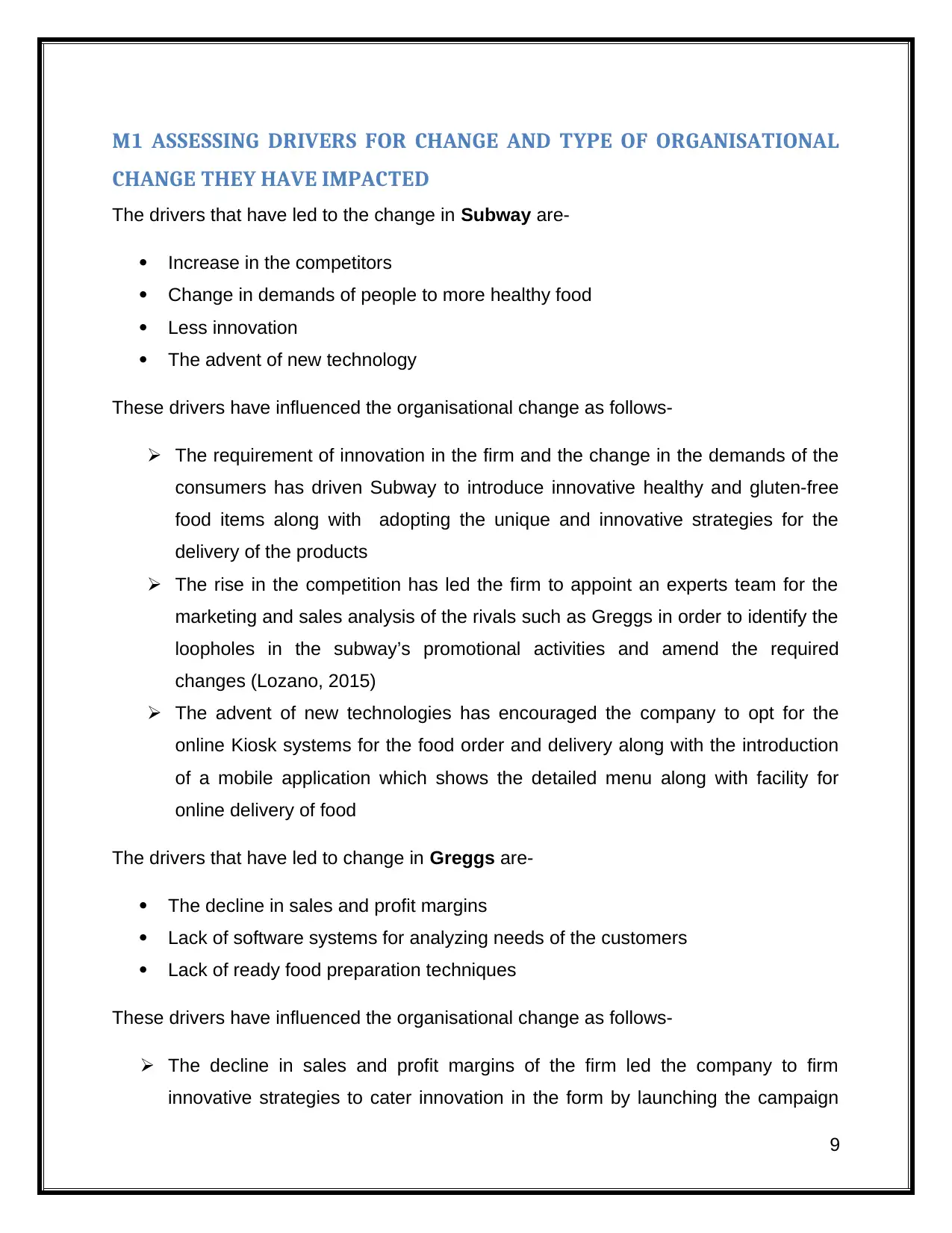
M1 ASSESSING DRIVERS FOR CHANGE AND TYPE OF ORGANISATIONAL
CHANGE THEY HAVE IMPACTED
The drivers that have led to the change in Subway are-
Increase in the competitors
Change in demands of people to more healthy food
Less innovation
The advent of new technology
These drivers have influenced the organisational change as follows-
The requirement of innovation in the firm and the change in the demands of the
consumers has driven Subway to introduce innovative healthy and gluten-free
food items along with adopting the unique and innovative strategies for the
delivery of the products
The rise in the competition has led the firm to appoint an experts team for the
marketing and sales analysis of the rivals such as Greggs in order to identify the
loopholes in the subway’s promotional activities and amend the required
changes (Lozano, 2015)
The advent of new technologies has encouraged the company to opt for the
online Kiosk systems for the food order and delivery along with the introduction
of a mobile application which shows the detailed menu along with facility for
online delivery of food
The drivers that have led to change in Greggs are-
The decline in sales and profit margins
Lack of software systems for analyzing needs of the customers
Lack of ready food preparation techniques
These drivers have influenced the organisational change as follows-
The decline in sales and profit margins of the firm led the company to firm
innovative strategies to cater innovation in the form by launching the campaign
9
CHANGE THEY HAVE IMPACTED
The drivers that have led to the change in Subway are-
Increase in the competitors
Change in demands of people to more healthy food
Less innovation
The advent of new technology
These drivers have influenced the organisational change as follows-
The requirement of innovation in the firm and the change in the demands of the
consumers has driven Subway to introduce innovative healthy and gluten-free
food items along with adopting the unique and innovative strategies for the
delivery of the products
The rise in the competition has led the firm to appoint an experts team for the
marketing and sales analysis of the rivals such as Greggs in order to identify the
loopholes in the subway’s promotional activities and amend the required
changes (Lozano, 2015)
The advent of new technologies has encouraged the company to opt for the
online Kiosk systems for the food order and delivery along with the introduction
of a mobile application which shows the detailed menu along with facility for
online delivery of food
The drivers that have led to change in Greggs are-
The decline in sales and profit margins
Lack of software systems for analyzing needs of the customers
Lack of ready food preparation techniques
These drivers have influenced the organisational change as follows-
The decline in sales and profit margins of the firm led the company to firm
innovative strategies to cater innovation in the form by launching the campaign
9
Paraphrase This Document
Need a fresh take? Get an instant paraphrase of this document with our AI Paraphraser
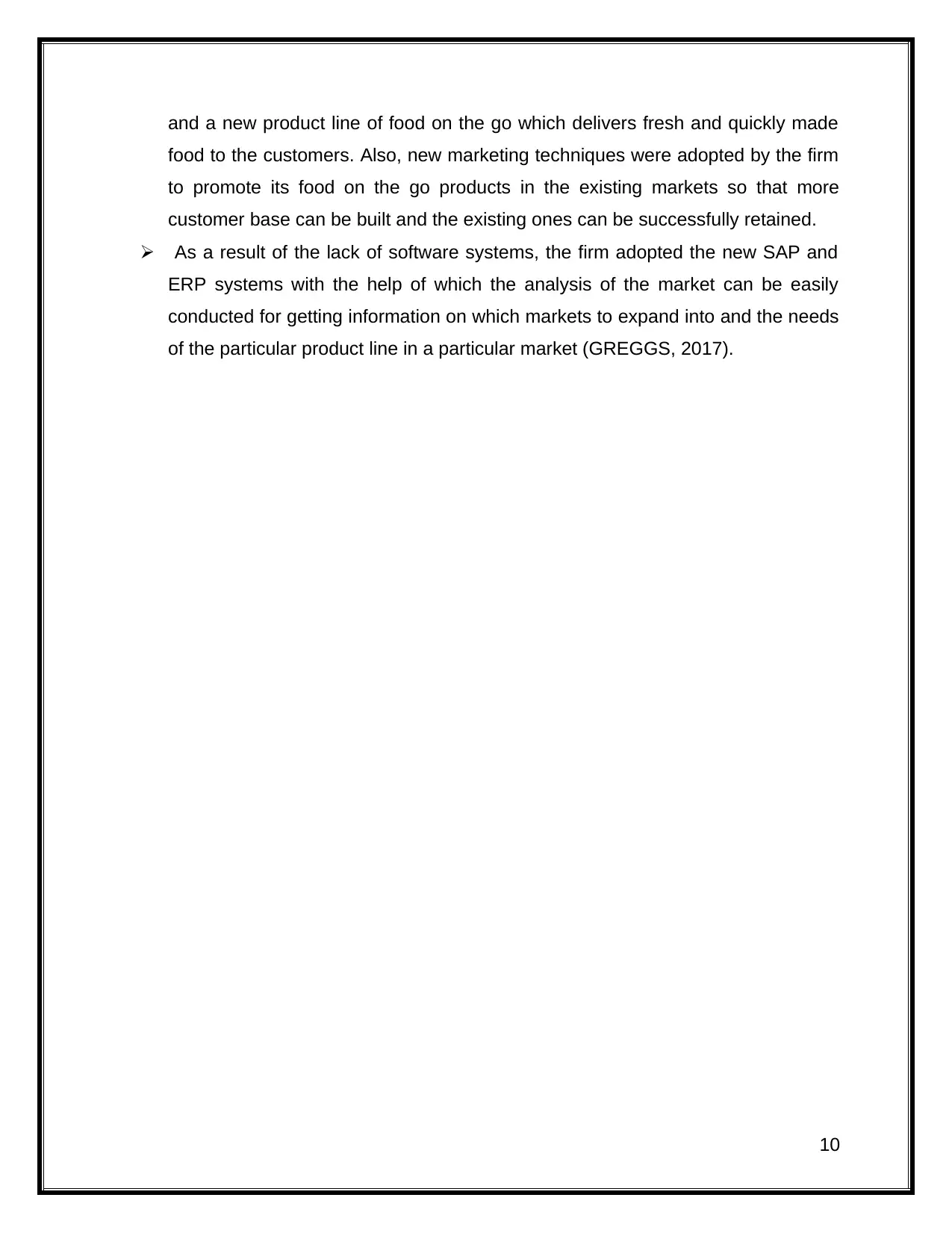
and a new product line of food on the go which delivers fresh and quickly made
food to the customers. Also, new marketing techniques were adopted by the firm
to promote its food on the go products in the existing markets so that more
customer base can be built and the existing ones can be successfully retained.
As a result of the lack of software systems, the firm adopted the new SAP and
ERP systems with the help of which the analysis of the market can be easily
conducted for getting information on which markets to expand into and the needs
of the particular product line in a particular market (GREGGS, 2017).
10
food to the customers. Also, new marketing techniques were adopted by the firm
to promote its food on the go products in the existing markets so that more
customer base can be built and the existing ones can be successfully retained.
As a result of the lack of software systems, the firm adopted the new SAP and
ERP systems with the help of which the analysis of the market can be easily
conducted for getting information on which markets to expand into and the needs
of the particular product line in a particular market (GREGGS, 2017).
10
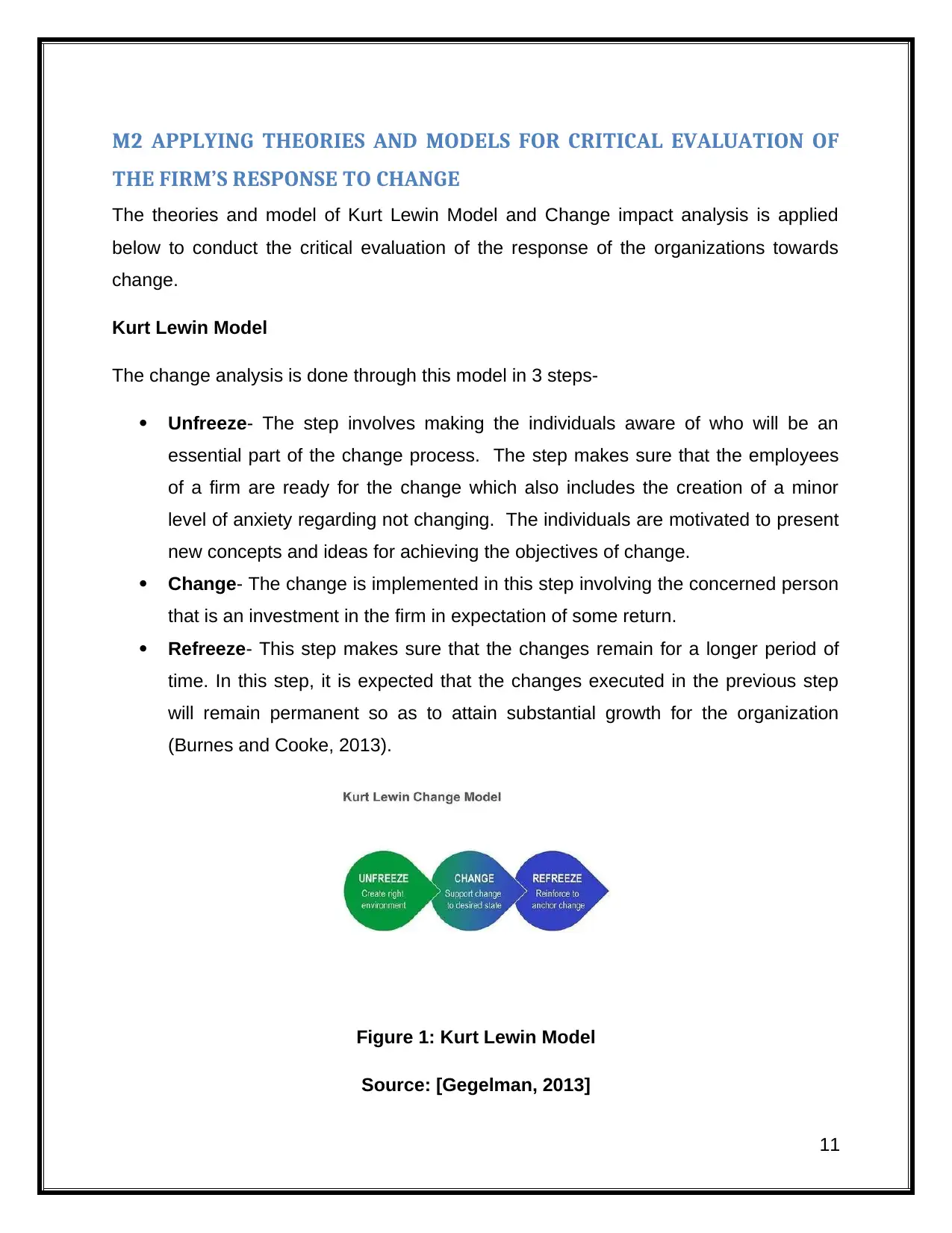
M2 APPLYING THEORIES AND MODELS FOR CRITICAL EVALUATION OF
THE FIRM’S RESPONSE TO CHANGE
The theories and model of Kurt Lewin Model and Change impact analysis is applied
below to conduct the critical evaluation of the response of the organizations towards
change.
Kurt Lewin Model
The change analysis is done through this model in 3 steps-
Unfreeze- The step involves making the individuals aware of who will be an
essential part of the change process. The step makes sure that the employees
of a firm are ready for the change which also includes the creation of a minor
level of anxiety regarding not changing. The individuals are motivated to present
new concepts and ideas for achieving the objectives of change.
Change- The change is implemented in this step involving the concerned person
that is an investment in the firm in expectation of some return.
Refreeze- This step makes sure that the changes remain for a longer period of
time. In this step, it is expected that the changes executed in the previous step
will remain permanent so as to attain substantial growth for the organization
(Burnes and Cooke, 2013).
Figure 1: Kurt Lewin Model
Source: [Gegelman, 2013]
11
THE FIRM’S RESPONSE TO CHANGE
The theories and model of Kurt Lewin Model and Change impact analysis is applied
below to conduct the critical evaluation of the response of the organizations towards
change.
Kurt Lewin Model
The change analysis is done through this model in 3 steps-
Unfreeze- The step involves making the individuals aware of who will be an
essential part of the change process. The step makes sure that the employees
of a firm are ready for the change which also includes the creation of a minor
level of anxiety regarding not changing. The individuals are motivated to present
new concepts and ideas for achieving the objectives of change.
Change- The change is implemented in this step involving the concerned person
that is an investment in the firm in expectation of some return.
Refreeze- This step makes sure that the changes remain for a longer period of
time. In this step, it is expected that the changes executed in the previous step
will remain permanent so as to attain substantial growth for the organization
(Burnes and Cooke, 2013).
Figure 1: Kurt Lewin Model
Source: [Gegelman, 2013]
11
⊘ This is a preview!⊘
Do you want full access?
Subscribe today to unlock all pages.

Trusted by 1+ million students worldwide
1 out of 26
Related Documents
Your All-in-One AI-Powered Toolkit for Academic Success.
+13062052269
info@desklib.com
Available 24*7 on WhatsApp / Email
![[object Object]](/_next/static/media/star-bottom.7253800d.svg)
Unlock your academic potential
Copyright © 2020–2025 A2Z Services. All Rights Reserved. Developed and managed by ZUCOL.


